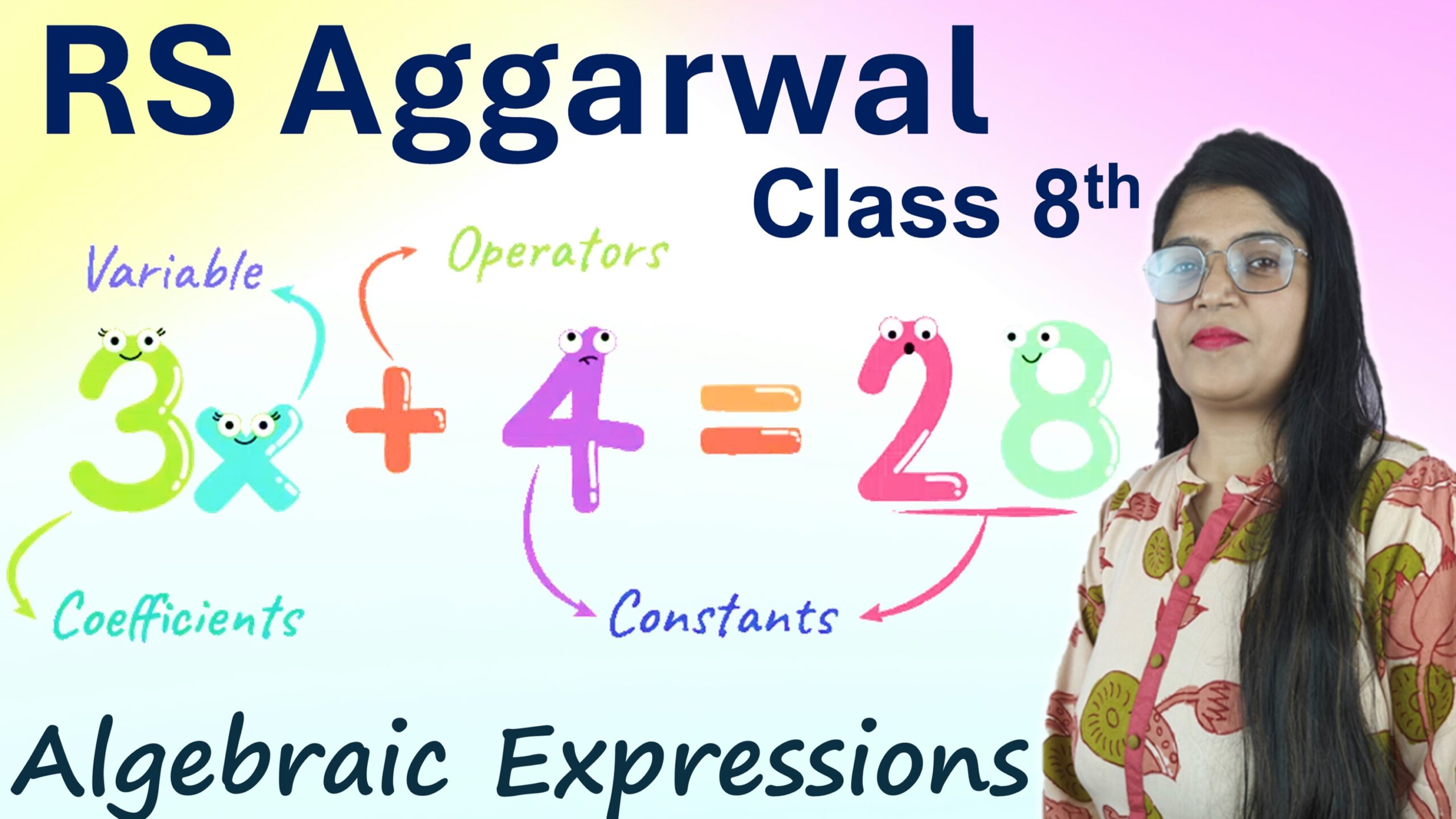Exercise: 2-E
Multiple Choice Type
Q1: The rational number equivalent to \(\frac{-2}{3}\) and with numerator -10 is:
We need to find the rational number equivalent to \(\frac{-2}{3}\) with numerator -10. We multiply both the numerator and denominator by the same factor:
\[
\frac{-2}{3} \times \frac{5}{5} = \frac{-10}{15}
\]
Answer:iii. \(\frac{-10}{15}\)
Q2: The largest rational numbers out of \(\frac{-5}{6}, \frac{-19}{24}, \frac{37}{-12}\) is:
First, we compare the numbers. The fractions are:
\[
\frac{-5}{6}, \frac{-19}{24}, \frac{37}{-12}
\]
\(\frac{-19}{24}\) is greater than the other two, as \(\frac{-5}{6}\) and \(\frac{37}{-12}\) are more negative.
Answer:ii. \(\frac{-19}{24}\)
Q3: \(\frac{-88}{-136}\) in standard form is:
We know that a negative divided by a negative is positive, so:
\[
\frac{-88}{-136} = \frac{11}{17}
\]
Answer:iii. \(\frac{11}{17}\)
Q4: \(-\frac{3}{5}\) and \(-\frac{1}{3}\) are two rational numbers, then:
To compare \(-\frac{3}{5}\) and \(-\frac{1}{3}\), we convert them to have a common denominator:
\[
-\frac{3}{5} = -\frac{9}{15}, \quad -\frac{1}{3} = -\frac{5}{15}
\]
Since \(-\frac{9}{15}\) is less than \(-\frac{5}{15}\), we have:
\[
-\frac{3}{5} < -\frac{1}{3}
\]
Answer:ii. \(-\frac{1}{3} > -\frac{3}{5}\)
Q5: According to the number line given above, the values of A and B are:
The positions of A and B on the number line correspond to:
\[
A = -\frac{7}{4}, \quad B = \frac{7}{3}
\]
Answer:iii. A = \(-\frac{7}{4}\) and B = \(\frac{7}{3}\)
Q6: The rational number between \(-\frac{1}{3}\) and \(\frac{1}{3}\) is:
The rational number between \(-\frac{1}{3}\) and \(\frac{1}{3}\) can be 0, as it lies between the two values.
Answer:iii. 0
Q7: A boy walks \(\frac{2}{3}\) km from a place P towards north and then from there \(\frac{5}{6}\) km towards south. The position of the boy from the place P is:
The total distance covered is:
\[
\frac{2}{3} – \frac{5}{6} = \frac{4}{6} – \frac{5}{6} = \frac{-1}{6}
\]
Thus, the position is \(\frac{1}{6}\) km towards south.
Answer:ii. \(\frac{1}{6}\) km towards south
Q8: The rational number that should be added to \(-\frac{3}{7}\) to get \(-\frac{5}{7}\) is:
To find the number to add, we subtract \(-\frac{3}{7}\) from \(-\frac{5}{7}\):
\[
-\frac{5}{7} – \left(-\frac{3}{7}\right) = -\frac{5}{7} + \frac{3}{7} = -\frac{2}{7}
\]
Answer:iii. \(-\frac{2}{7}\)
Q9: The rational number that should be subtracted from \(-\frac{2}{7}\) to get \(-\frac{5}{7}\) is:
To find the number to subtract, we subtract \(-\frac{2}{7}\) from \(-\frac{5}{7}\):
\[
-\frac{2}{7} – \left(-\frac{5}{7}\right) = -\frac{2}{7} + \frac{5}{7} = \frac{3}{7}
\]
Answer:\(\frac{3}{7}\)
Q10: The sum of two rational numbers is 2. If one of them is \(-\frac{1}{2}\); the other is:
Let the other rational number be \(x\). We have:
\[
x + \left(-\frac{1}{2}\right) = 2
\]
Solving for \(x\):
\[
x = 2 + \frac{1}{2} = \frac{5}{2}
\]
Answer:i. \(\frac{5}{2}\)
Q11: If the cost of 1 m cloth is ₹\(20\frac{5}{8}\), then the cost of \(2\frac{2}{7}\) m is:
We multiply the cost per meter by the length of the cloth:
\[
20\frac{5}{8} \times 2\frac{2}{7} = \left(\frac{165}{8}\right) \times \left(\frac{16}{7}\right) = \frac{165 \times 16}{8 \times 7} = \frac{2640}{56} = ₹\ 47\frac{2}{7}
\]
Answer:iii. ₹\(\left(20\frac{5}{8} \times 2\frac{2}{7}\right)\)
Q12: The product of two rational numbers is -1. If one of them is \(\frac{5}{6}\), then the other rational number is:
Let the other rational number be \(x\). We have:
\[
x \times \frac{5}{6} = -1
\]
Solving for \(x\):
\[
x = -\frac{6}{5}
\]
Answer:ii. \(-\frac{6}{5}\)
Q13: The distance covered in \(2\frac{2}{9}\) hours at the speed of \(5\frac{2}{5}\) km per hour is:
The distance covered is:
\[
\left(2\frac{2}{9}\right) \times \left(5\frac{2}{5}\right) = \frac{20}{9} \times \frac{27}{5} = \frac{540}{45} = 12 \text{ km}
\]
Answer:iv. \(\left(\frac{27}{5} \times \frac{20}{9}\right)\) km
Q14: \(2\frac{5}{8}\) divided by \(1\frac{1}{6}\) gives:
We divide \(2\frac{5}{8}\) by \(1\frac{1}{6}\):
\[
2\frac{5}{8} \div 1\frac{1}{6} = \frac{21}{8} \div \frac{7}{6} = \frac{21}{8} \times \frac{6}{7} = \frac{126}{56} = 2\frac{1}{4}
\]
Answer:iii. \(2\frac{1}{4}\)
Q15: \(-\frac{1}{3}, \frac{-5}{9}\) and \(\frac{-4}{3}\) ascending order are:
The ascending order is:
\[
\frac{-4}{3} < \frac{-5}{9} < -\frac{1}{3}
\]
Answer:iii. \(\frac{-4}{3} < \frac{-5}{9} < -\frac{1}{3}\)
Q16: Statement 1: \(1.6666…\) can be expressed as a rational number.
Statement 2: A decimal number is said to be non-terminating but recurring decimal if its decimal part a digit or a group of digits repeats itself again and again.
Which of the following options is correct?
Both statements are true, as \(1.6666…\) is a recurring decimal and can be expressed as \(\frac{5}{3}\).
Answer:i. Both the statements are true.
Q17: Assertion (A): The product of two rational numbers is \(\frac{3}{8}\). If one of them is \(-\frac{3}{20}\), then the other number is \(-\frac{5}{2}\).
Reason (R): In multiplication of two rational numbers, the numerator and denominator of the product of rational numbers are equal to the product of their individual numerators and denominators.
The product of two rational numbers can be calculated by multiplying their numerators and denominators separately. Let the two rational numbers be \(\frac{a}{b}\) and \(\frac{c}{d}\). The product of these rational numbers is:
\(\frac{a}{b} \times \frac{c}{d} = \frac{a \times c}{b \times d}\)
Given that the product is \(\frac{3}{8}\), and one of the numbers is \(-\frac{3}{20}\), let’s assume the other number is \(\frac{x}{y}\):
\(\frac{-3}{20} \times \frac{x}{y} = \frac{3}{8}\)
Cross-multiplying:
-3x = 3 \times 20 and 20y = 8 \times y
Simplifying gives \(x = -\frac{5}{2}\), confirming the assertion.
Conclusion: Assertion (A) is true. Reason (R) is true, because the product of two rational numbers is indeed the product of their numerators and denominators.
Answer:iii. Both A and R are true.
Q18: Assertion (A): On dividing the sum of \(\frac{65}{12}\) and \(\frac{8}{3}\) by their difference, you get \(\frac{97}{33}\).
Reason (R): If \(\frac{p}{q}\) and \(\frac{r}{s}\) are two rational numbers such that \(\frac{p}{q} \neq 0\), then \(\frac{p}{q} \div \frac{r}{s} = \frac{p}{q} \times \frac{s}{r}\).
Solution:
The sum of \(\frac{65}{12}\) and \(\frac{8}{3}\):
\(\frac{65}{12} + \frac{8}{3} = \frac{65}{12} + \frac{32}{12} = \frac{97}{12}\)
The difference between \(\frac{65}{12}\) and \(\frac{8}{3}\):
\(\frac{65}{12} – \frac{8}{3} = \frac{65}{12} – \frac{32}{12} = \frac{33}{12}\)
Now, divide the sum by the difference:
\(\frac{\frac{97}{12}}{\frac{33}{12}} = \frac{97}{33}\)
Conclusion: Assertion (A) is true, and Reason (R) is also true.
Answer:iii. Both A and R are true.
Q19: Assertion (A): 1 and 0 are two co-prime integers, hence \(\frac{1}{0}\) is rational.
Reason (R): Every integer is a rational number. Its converse is also true.
1 and 0 are co-prime integers, but division by 0 is undefined. Thus, \(\frac{1}{0}\) is not a rational number.
Conclusion: Assertion (A) is false because division by zero is undefined. Reason (R) is true because every integer can be expressed as a rational number.
Answer:iv. Both A and R are false.
Q20: Assertion (A): \(\frac{34}{-51}\) and \(\frac{-2}{3}\) are equivalent rational numbers.
Reason (R): If \(\frac{p}{q}\) is a rational number and n is a non-zero integer, then \(\frac{p \times n}{q \times n} = \frac{p}{q}\).
The given rational numbers are \(\frac{34}{-51}\) and \(\frac{-2}{3}\). Simplifying \(\frac{34}{-51}\), we get:
\(\frac{34}{-51} = \frac{-2}{3}\)
Thus, the two numbers are equivalent. The reason is correct because multiplying or dividing a rational number by a non-zero integer doesn’t change its equivalence.
Conclusion: Assertion (A) is true, and Reason (R) is true.
Answer:iii. Both A and R are true.






